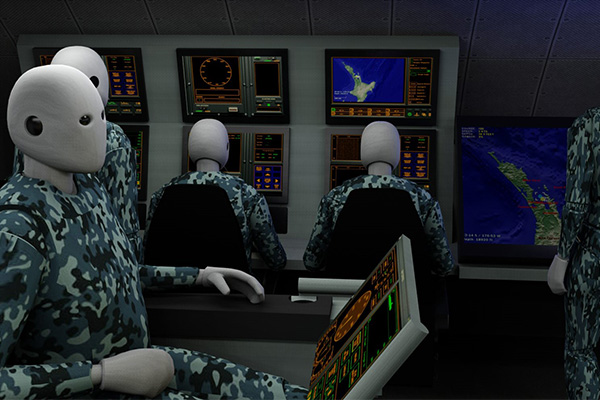The problem
Submariners live and work within submarines for months on end, operating under extreme mental load within high-stakes settings. In addition to this isolation and intensity, crew members must endure a lack of sunlight, a lack of sleep, and distinct lack of space. While these military personnel are highly skilled, these dark and cramped conditions are unconducive with peak mental and physical performance.
The solution
If we can’t make a submarine bigger, how can we make its interior feel bigger? A team of researchers from the University of South Australia (UniSA) have answered that very question – an outcome that has inspired design considerations for Australia’s current submarine interiors and will inform design assurance activities of the country’s future fleet.
This research collaboration has been extensive and began with a 2015 survey of the body sizes and shapes of more than 1300 Royal Australian Navy (RAN) personnel.
Since then, UniSA biomechanics expert Dr Francois Fraysse, who works within UniSA’s Alliance for Research in Exercise, Nutrition and Activity centre (ARENA) has also captured data on flexibility, reach capacity, strength, and movement in tight spaces.
“By understanding the size and physical capacity of our RAN personnel, we get a better understanding of how to design an environment that truly accommodates them,” Dr Fraysse said.
Dr Peter Schumacher, Director of UniSA’s Studio for Complex Human Environment Design (SCHED), has used this data to create digital replicas of Australia’s RAN personnel.
“We’ve leveraged industrial design and computer aided design (CAD) to create digital models of Australia’s submarine interiors, which allows us to get a better sense of the space,” Dr Schumacher explained.
 Caption: The University of South Australia (UniSA) has created digital models of Royal Australian Navy (RAN) personnel, and submarine quarters, to inform improvements to the country’s submersibles – with human habitability and performance at the centre of the research.
Caption: The University of South Australia (UniSA) has created digital models of Royal Australian Navy (RAN) personnel, and submarine quarters, to inform improvements to the country’s submersibles – with human habitability and performance at the centre of the research.
“Then, we’ve placed our human replicas – also known as Human Digital Models – within this digital realm, so we can see how varying body shapes and sizes occupy the space.
“We’ve brought in Virtual Reality technology to allow our team to embody these RAN personnel, so we can now experience what it is like to be a medium-sized male within a submarine, or a tall female.
“This allows us to get a true sense of how these people move within the submarine, which informs interior design changes and ensures submarine quarters are conducive to human habitability.
“It truly is a battle of millimetres, as small space changes can allow someone to get a better night sleep or take a proper shower… and this, in turn, can result in better performance or enhance cognitive performance of submariners.”
UniSA sleep expert, Professor Siobhan Banks, who is the Director of the university’s Behaviour-Brain-Body (BBB) Research Centre, has also contributed significant findings and outcomes to the project.
Professor Banks has focused on the impact of sleep deprivation on psychological and physiological functioning and how countermeasures within a submarine environment may be used to prevent the negative effects of disturbed sleep, and, thereby, improve cognitive performance and decision-making.
“Everything comes down to sleep – if you cannot get a good sleep, and then you’re working under extreme mental load, your mental processing, your decision-making, and your emotions are far from optimal,” Professor Banks says.
“We have looked at how the interior of a submarine, especially its sleeping quarters, can assist our RAN crew members to perform at their very best.
“In our research our prototype designs have ensured that lighting is optimised, that beds are not too narrow, and that noise is mitigated as much as possible, along with other measures.”
UniSA’s submarine work has been conducted in collaboration with leading defence primes and the Defence Science and Technology Group.
The groundbreaking insights from this work has placed Australia at the forefront of human-centred design research in naval architecture.
The work aims to transform the submariners’ day-to-day lives and has also informed the creation of a new naval operator combat console for another defence prime.
Ultimately, the outcome of UniSA’s research aims to enhance human performance at sea, and bolster Australia’s position in the Indo-Pacific region.
UniSA supports defence industry capability, innovation and growth through collaborative research projects. Enhance your defence capabilities by connecting with the UniSA Enterprise Hub. Make an online enquiry or phone us on 08 8302 3482.
Related services
Contact the Enterprise Hub
Get in touch with us to find out how we can support your business needs.
Make an enquiry online or call us to discuss your idea




